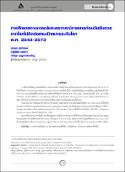บทคัดย่อ
การศึกษานี้มีวัตถุประสงค์เพื่อศึกษาสถานการณ์การเสียชีวิตก่อนวัยอันควรของประชากรไทยช่วงอายุ 30-70 ปี จากโรคไม่ติดต่อ (noncommunicable diseases: NCDs) 4 กลุ่มโรค ได้แก่ กลุ่มโรคหัวใจและหลอดเลือด กลุ่มโรคมะเร็ง โรคเบาหวาน และกลุ่มโรคที่เกี่ยวกับระบบทางเดินหายใจเรื้อรัง ระหว่าง พ.ศ. 2543-2561 และพยากรณ์ถึง พ.ศ. 2573 เพื่อประเมินความเป็นไปได้ของการบรรลุเป้าหมายหนึ่งของ Sustainable Development Goals (SDGs) หรือเป้าหมายการพัฒนาที่ยั่งยืนในการลดการตายก่อนวัยอันควรที่มีสาเหตุจากโรคไม่ติดต่อลงหนึ่งในสาม ประมาณการจากข้อมูลสำนักบริหารการทะเบียน กรมการปกครอง กระทรวงมหาดไทย พ.ศ. 2543-2561 ซึ่งให้รหัสสาเหตุการตายโดยกองยุทธศาสตร์และแผนงาน กระทรวงสาธารณสุข และปรับสาเหตุการตายจากมรณบัตรด้วยผลการศึกษาสาเหตุการตายโดยการสัมภาษณ์และทบทวนเวชระเบียน และพยากรณ์การเสียชีวิตก่อนวัยอันควรด้วยวิธีการ Bayesian model averaging (BMA) ไปจนถึง พ.ศ. 2573 ผลการศึกษาพบว่า หากไม่มีการเปลี่ยนแปลงจากอดีต โอกาสของการเสียชีวิตก่อนวัยอันควรของ 4NCDs ในภาพรวมของประเทศอาจจะไม่ได้ตามเป้าหมาย SDGs ที่ร้อยละ 9.9 ใน ค.ศ. 2030 แต่ผลการพยากรณ์อยู่ที่ร้อยละ 12.0 (10.6-13.6) ซึ่งเพศหญิงมีโอกาสในการบรรลุเป้าหมายสูงกว่าเพศชาย และโรคทางเดินหายใจเรื้อรังมีโอกาสบรรลุเป้าหมายได้มากที่สุด
บทคัดย่อ
This study aimed to assess the situation of premature mortality due to four noncommunicable diseases (cardiovascular diseases, cancers, diabetes, and chronic respiratory diseases) between 2000-2018 in the Thai population aged 30 to 70 years, and the feasibility of achieving the Sustainable Development Goals (SDGs) of reducing premature death by one-third by 2030. We estimated premature mortality using civil registration and vital statistics (CRVS) from the Bureau of Registration Administration with cause of death coded by the Strategy and Policy Division. Verbal autopsy data were applied to improve accuracy of causes of death from the vital registry. We predicted the premature mortality up to 2030 using Bayesian model averaging (BMA). The findings showed that given the current historical trend, achievement of the SDG target of 9.9% by 2030 was unlikely, as we predicted it to be 12.0% (95%CI, 10.6-3.6). However, this goal is more likely to be achievable in women than men. Among the four NCDs, respiratory diseases are most likely to reach the target.


